Syrian rebels, led by the Islamist group Hayat Tahrir Al-Sham (HTS), have successfully captured the strategic city of Hama in a significant victory against President Bashar Al-Assad’s forces.
In the city the whole can be defined in the same way can be classified in the same condition with the fall of Hama, which had remained under government control since the onset of the Syrian Civil War in 2011, marks a critical shift in the ongoing conflict and a major setback for Assad’s military.
he Syrian Army confirmed that it had lost control of the city, acknowledging intense clashes with the rebel forces. In a statement, the Army explained that rebel groups had breached several fronts in Hama, forcing a redeployment of government forces outside the city in order to protect civilian lives and avoid urban warfare. Rebel fighters were seen parading through the city in the evening, freeing prisoners from Hama’s detention center amid celebratory gunfire.
Hama, strategically located in central Syria, has long been considered vital for Assad’s control over the western part of the country, including the capital, Damascus. Its loss represents a significant blow to Assad’s efforts to maintain a firm grip on Syria’s core regions. The fall of Hama also comes just days after rebel forces made significant gains in Aleppo, Syria’s second-largest city, which had been under Assad’s control since 2016, following Russian-backed offensives.
The battle for Hama had been intensifying since Tuesday, with rebels reaching the city’s gates and sparking large-scale displacement among civilians. Despite a counteroffensive by government forces, the rebels stormed the city from multiple directions, engaging in fierce street battles that eventually led to the city’s fall.
The loss of Hama further undermines Assad’s position, particularly as he faces mounting pressure from both rebel groups and foreign adversaries, including Turkey, which supports the opposition. The victory also signals the growing strength of HTS and its allies, raising concerns about the future stability of Syria’s already fragmented landscape.
As the war enters its 14th year, the situation remains volatile, with shifting allegiances and intensifying battles across the country.



